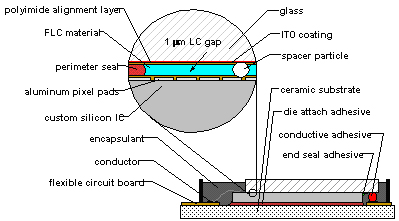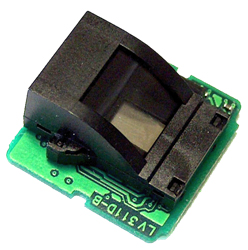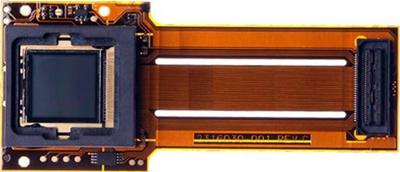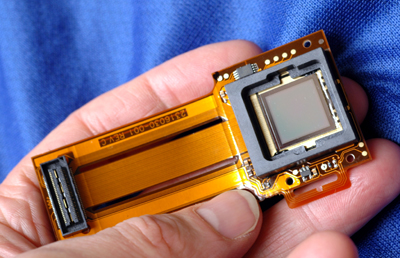FLCOS technology sets off a revolutionary trend in consumer electronics display
FLCOS displays have a wide color gamut and less "screen-door" effects, because FLCOS microdisplays use CMOS technology, enabling high-profile interconnect and package technology to achieve small form factor and low Power consumption and low cost.
This article refers to the address: http://
Consumer electronics manufacturers now have the opportunity to integrate high-quality video displays into small, portable communications devices such as cellular phones. Convenient access to video content over wired and wireless networks has attracted the attention of network service providers as they have the opportunity to sell video services to end users. The challenge in product design is to provide a display that is sized for comfortable viewing while maintaining the portable size requirements of the communication device. This article describes the use of ferroelectric liquid crystal on silicon (FLCOS) display technology to create an acceptable video display from a very small package, thus solving the dilemma of system design.
How FLCOS works
With a 25-year history of FLCOS microdisplay technology, it has delivered a total of 14 million products to date, positioning itself to enable consumers to comfortably view a variety of video images in a variety of new applications, including portable projectors. , car displays and near-to-eye displays, which can also be used for holographic data storage.
Conventional nematic liquid crystals have a switching time of 10ms. In contrast, FLCOS microdisplays with dedicated ferroelectric liquid crystal (FLC) have a switching time of less than 100us, which is the difference between them and other microdisplays. The fast switching speed allows one to overlay a layer of FLC on the surface of a CMOS silicon die to produce a full color display. The CMOS circuit interfaces with a standard video input and utilizes a CMOS process to implement a lattice mirror on the top layer of the metal.
Depending on the voltage applied by the CMOS circuit on the lattice metal, the FLC material interacts with light passing through the material, either rotating the polarized light or not rotating the polarized light. The FLCOS microdisplay utilizes the FLC's fast to generate a high frame rate sequence of red, green, and blue (RGB) images that are then synthesized by the human eye into a complete color image. Because the FLCOS microdisplay uses a CMOS process, it can be fabricated using a wide range of interconnect and packaging technologies, which is consistent with small size, low power, and consumer pricing models.
FLCOS microdisplays provide a versatile solution for many challenging engineers, enabling them to develop the next generation of consumer electronics products that comfortably view video images. The next-generation FLCOS microdisplays are ideal for high-definition personal display products, including head-mounted displays and ultra-small full-color projectors. These new FLCOS products are the result of research on high-volume QVGA electronic viewing mirrors, which have matured both in terms of manufacturing process and product design.

Figure 1: FLCOS microdisplay
Embedded projection device
A personal mobile electronic device that integrates a projection function is called an embedded projection device. These devices have strict constraints on projection components, size, power consumption, and cost. The overall flexibility of the FLCOS microdisplay provides design engineers with a unique opportunity to design embedded projection solutions for the next generation of personal mobile devices. The FLCOS panel provides display and display controllers, including control signals for LED drivers, and consumes less than 100mW. Because standard RGB video interfaces are designed in FLCOS microdisplays, engineers can focus their attention on the key design task of minimizing the power consumed by the projection source.
The size of FLCOS microdisplays is also critical to embedding projectors into personal devices such as cell phones, PDAs, and media players. FLCOS microdisplays are less than half an inch in package size, making them easy to integrate into most personal devices. Because the FLCOS device integrates a standard video interface, no additional interface components are required, reducing the space required to embed the projector.
While the new FLCOS microdisplay does not completely eliminate all of the challenges associated with embedding projectors in personal devices, they do have the potential to eliminate these challenges because of their unique FLCOS device characteristics.

Figure 2: Displaytech's LV311 device
Modular personal projection device
The modular personal projection device is designed to connect to other personal electronic devices. It is about the average PDA size. It must provide high-resolution projection images for business and entertainment applications, but it is still easy to put in pockets. in. In addition, compared to modular projection devices, people also care about the size, power consumption and standard interface of embedded projectors. In order to meet the needs of most consumers, the device must be light and power must be low in order for the projector to operate on the battery for a reasonable amount of time. Modular devices can also be powered by the power cord to extend the projector's operating time. Information can be fed into the projector via wire or wireless or some kind of portable memory.
The engineering and design of the microdisplay is very well designed, and the low power consumption makes the FLCOS solution an ideal solution for portable battery powered projectors. The fast switching speed offered by FLCOS microdisplays means that one display panel will produce full color and >90% of the reflective FLCOS apertures will produce high quality projected images.
Near-eye display application
FLCOS microdisplays have been used as electronic viewing mirrors in digital still cameras and video recorders, and over the past six years, more than 14 million FLCOS microdisplays have been delivered to the world's leading electronics manufacturers.
FLCOS microdisplays are being used in other "near-eye" display applications, for example, in head-mounted displays. In dual near-eye applications, the illumination source is a tri-color LED controlled by an electronic circuit integrated in the display panel. The LED light source is combined with the FLCOS microdisplay to provide light for near-eye applications.
For near-eye displays, an absolute requirement is to generate a full-color display using a single panel. Only FLCOS panels with very fast switching speeds are capable of producing very high frame rates required for sequential color display. The tiny aperture of the color tri-color panel allows the image you see in the near-eye display to look just like through the screen. FLCOS reflective displays utilize sequential color to create a desired color on an aperture of >90% per pixel, resulting in a holographic-like image.
When choosing a display, consider the color gamut provided by the display. Competitive near-eye displays use color filters that produce very limited color gamut to form their color three colors. The FLCOS panel utilizes three-color LEDs that generate a wider color domain to produce a color that is closer to life.
With the FLCOS microdisplay, the complex features of a successful near-eye display have been simplified. FLCOS offers a high quality full color display on a single microdisplay without the need for color dyes. Because of their small size and high functionality, such microdisplays are flexible enough to help engineers design an attractive near-eye display application.
Automotive electronics applications
Automotive applications are another area where FLCOS technology may prove to be disruptive. According to industry analyst firm DisplaySearch, the automotive display monitor market is growing at a two-speed rate and is expected to continue into 2010. In more and more cars, multi-function global positioning system (GPS) technology and driver information display systems are infiltrating into car dashboards. In many new car designs, entertainment-oriented displays are showing trends after being mounted to the roof and headrests. In addition, head-up displays that project information directly into the driver's line of sight use the windshield as a projection screen, and this new application is increasingly attracting automakers to stand out in the crowded auto market.
Miniature projection is a new technology for automotive applications. When automakers consider adopting a new technology, they have to do a certain period of testing and verification, including the use of the new technology in non-security areas like entertainment displays.
Holographic data storage
Holographic Data Storage (HDS) is a non-display application that can be implemented using FLCOS technology. In HDS applications, FLCOS devices are used as spatial light modulators (SLMs). According to leading technology market analyst firm IDC, HDS will begin to replace professional data storage solutions and video devices next year. By 2010 HDS will begin to replace consumer video and data optical storage products.

Figure 3: Spatial Light Modulator (SLM)
Holographic data storage technology breaks through the density limit of traditional storage technology. It not only records data on the surface of the storage medium, but records the data through the whole of the medium. Unlike other optical storage technologies that record one data bit at a time, holographic storage allows millions of bits of data to be read/written in parallel in one flash. This makes the transfer rate much higher than existing optical storage devices.
If used as an SLM, FLCOS can provide high speed data write rates. The overall cost is low due to the integrated electronics and simplified package. In addition, since the microdisplay manufacturing process is mature, mass production can be achieved quickly. FLCOS technology also provides high switching speed and light throughput, which is necessary for efficient switching of dark blue lasers in holographic data storage devices. The SLM maps the "0" and "1" of the electronic data to an optical pattern like a "checker board" composed of more than 1 million rays and dark pixels.

Figure 4: Another orientation view of the SLM
Summary of this article
The FLCOS microdisplay provides a versatile solution to several issues facing the consumer electronics engineering community. FLCOS technology has been proven in the consumer field and has become a major component of electronic viewing mirrors in digital video cameras and video recorders. Currently, high resolution FLCOS displays are being offered to target several different new display applications across many different markets, including those described above.
One of the challenges for all revolutionary technologies is that the development of most consumer electronics is constantly evolving. The product revolution can only happen when a number of complementary new technologies are available in a relatively short period of time. Today, the popularity of FLCOS, high-brightness LEDs and lasers, and consumer video content seems likely to trigger a revolution in display.
High efficient charging speed for Toshiba laptop, stable current outlet can offer power for the laptop at the same time charge the laptop battery. The best choice for your replacement adapter. We can meet your specific requirement of the products, like label design. The plug type is US/UK/AU/EU. The material of this product is PC+ABS. All condition of our product is 100% brand new.
Our products built with input/output overvoltage protection, input/output overcurrent protection, over temperature protection, over power protection and short circuit protection. You can send more details of this product, so that we can offer best service to you!
Toshiba Adapter,Adapter For Toshiba,Power Supply For Toshiba,Laptop Charger For Toshiba
Shenzhen Waweis Technology Co., Ltd. , https://www.waweis.com